Abstract
During the 1970 to 1971 nationwide epidemic of septicemias caused by Enterobacter cloacae and Enterobacter agglomerans traced to intrinsic contamination of Abbott intravenous infusion products, 94 infusion systems manufactured by Baxter Laboratories were studied microbiologically and epidemiologically during hospital use. Intravenous fluid from 10 systems (11%) contained microorganisms, usually Staphylococcus or Bacillus species; one infusion was heavily contaminated with Klebsiella pneumoniae. No national epidemic organisms, E. cloacae or E. agglomerans (formerly Erwinia), were recovered, suggesting that during this period frequent contamination with these organisms was unique to Abbott's infusion products. Contamination in this study appeared to be extrinsic in origin (introduced during clinical use) and related to the duration of continuous intravenous therapy. Nine of 61 systems (15%) that had been used longer than 48 h were contaminated, whereas only 1 of 33 used less than 48 h (3%) contained microorganisms. This study and the recent national outbreak indicate that contamination of infusion fluid, both from intrinsic and extrinsic sources, must be recognized as an additional risk of intravenous therapy; however, a once-daily replacement of the delivery apparatus can significantly diminish this hazard.
Full text
PDF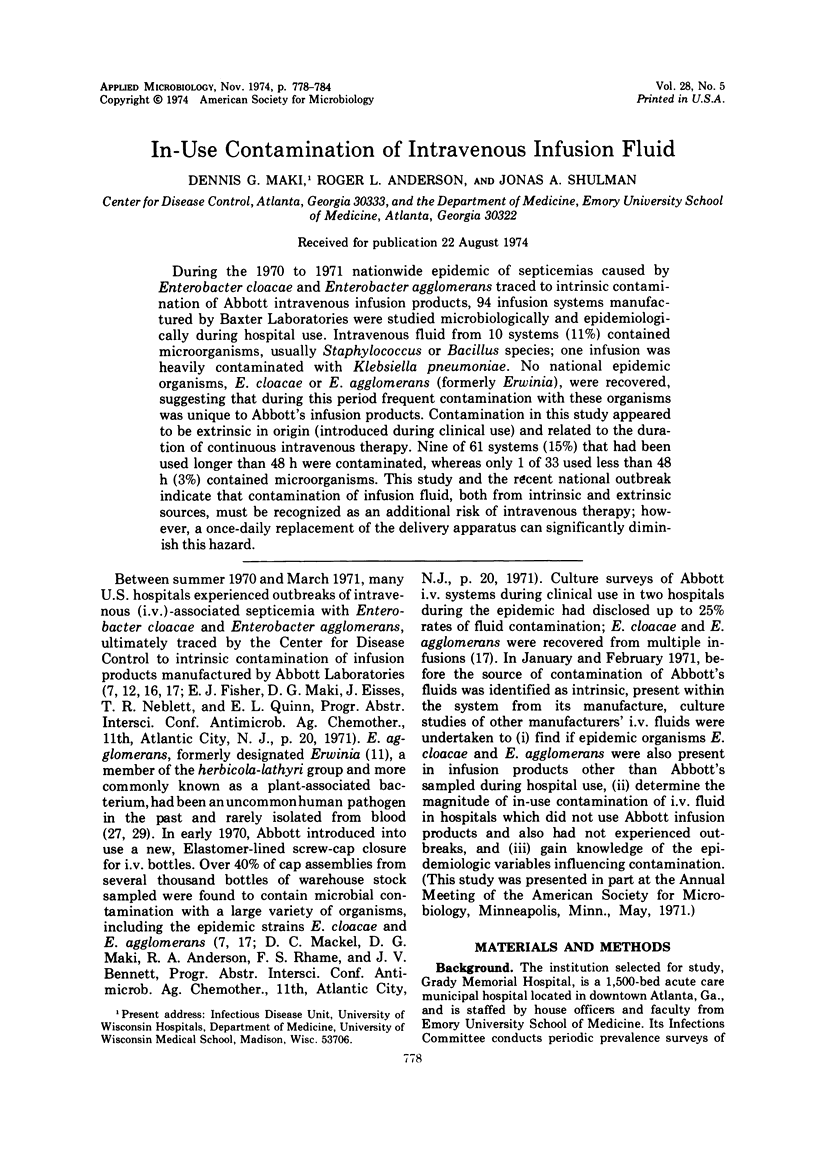
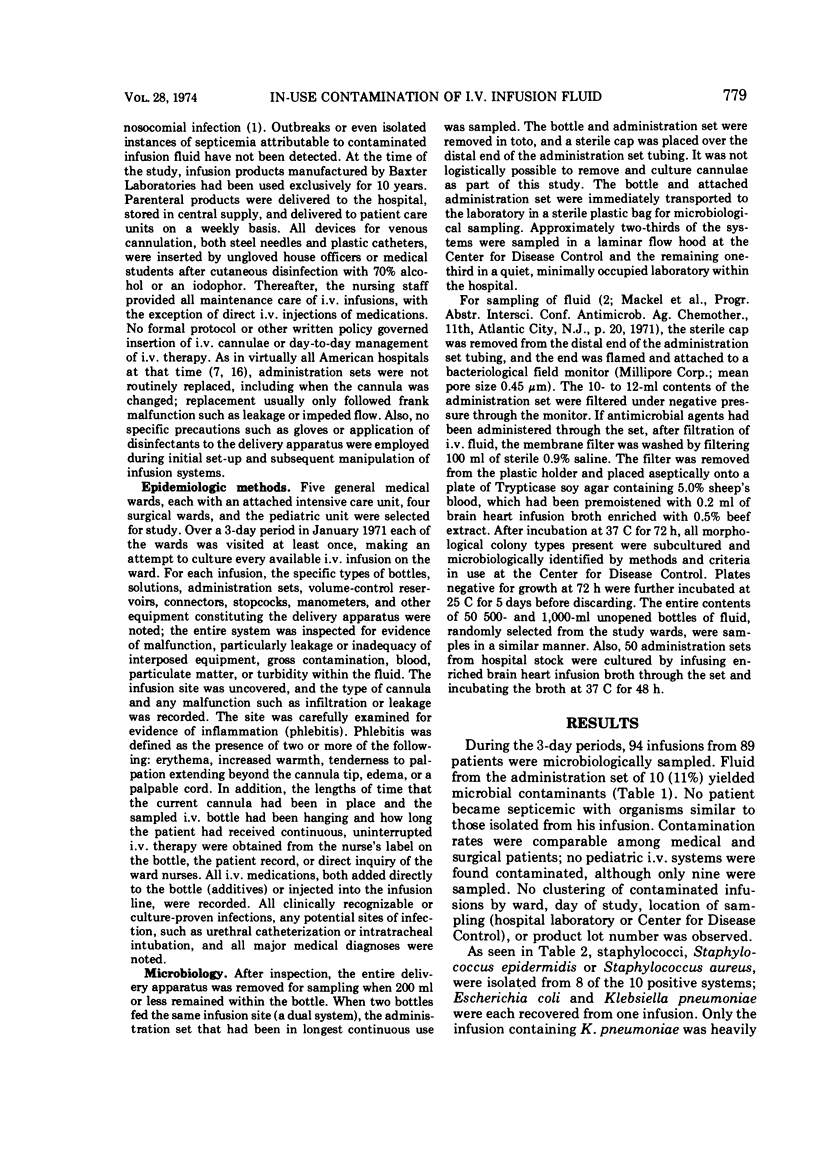
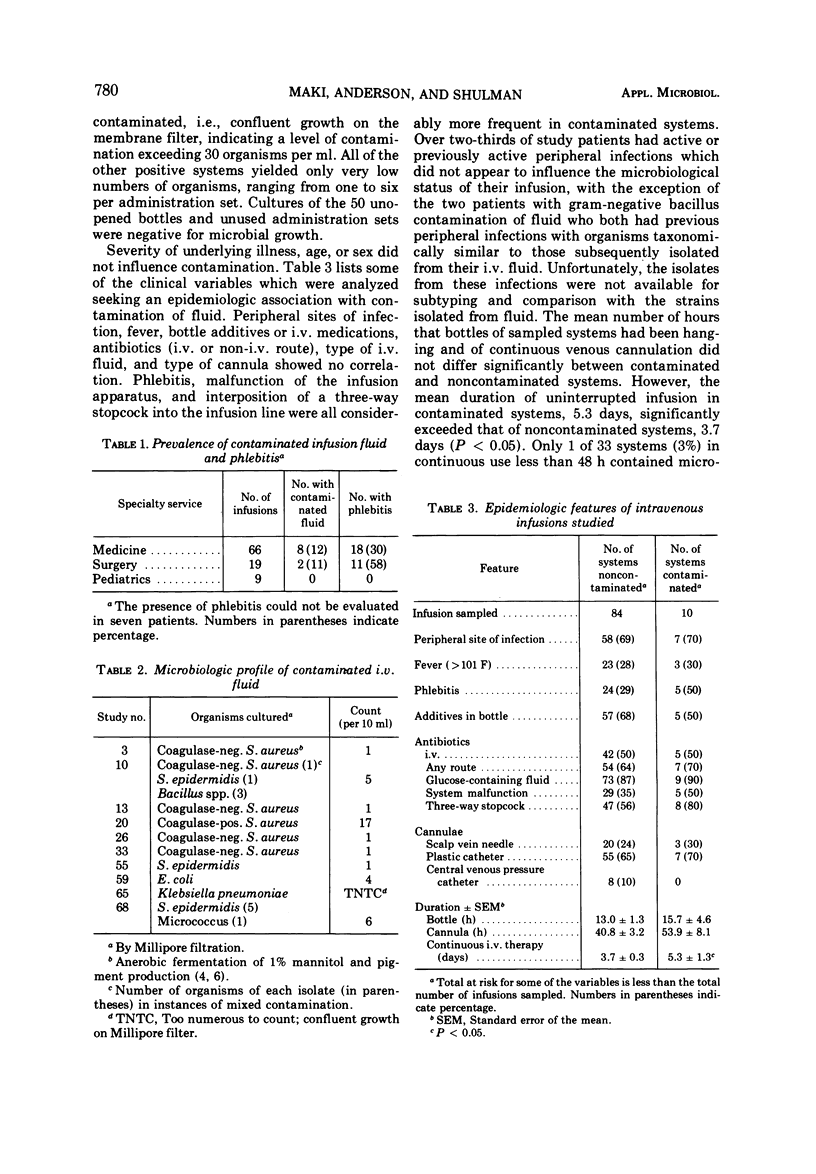
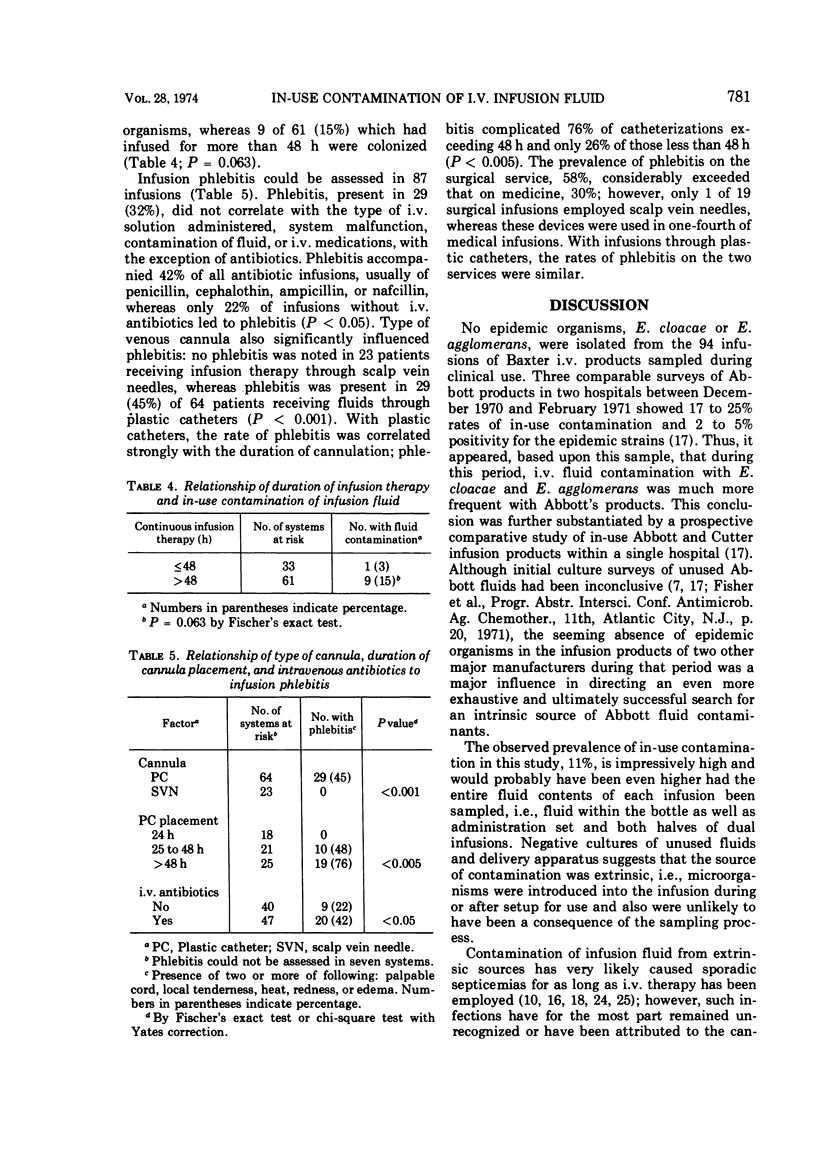
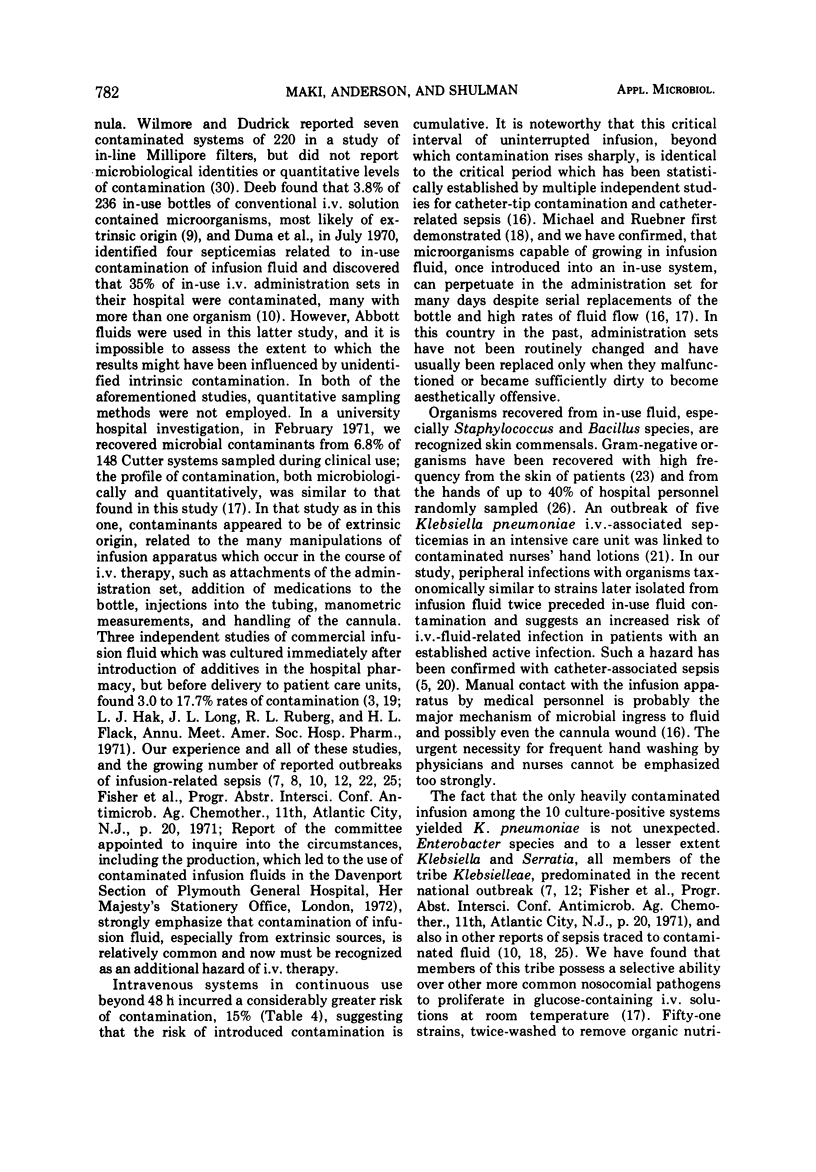
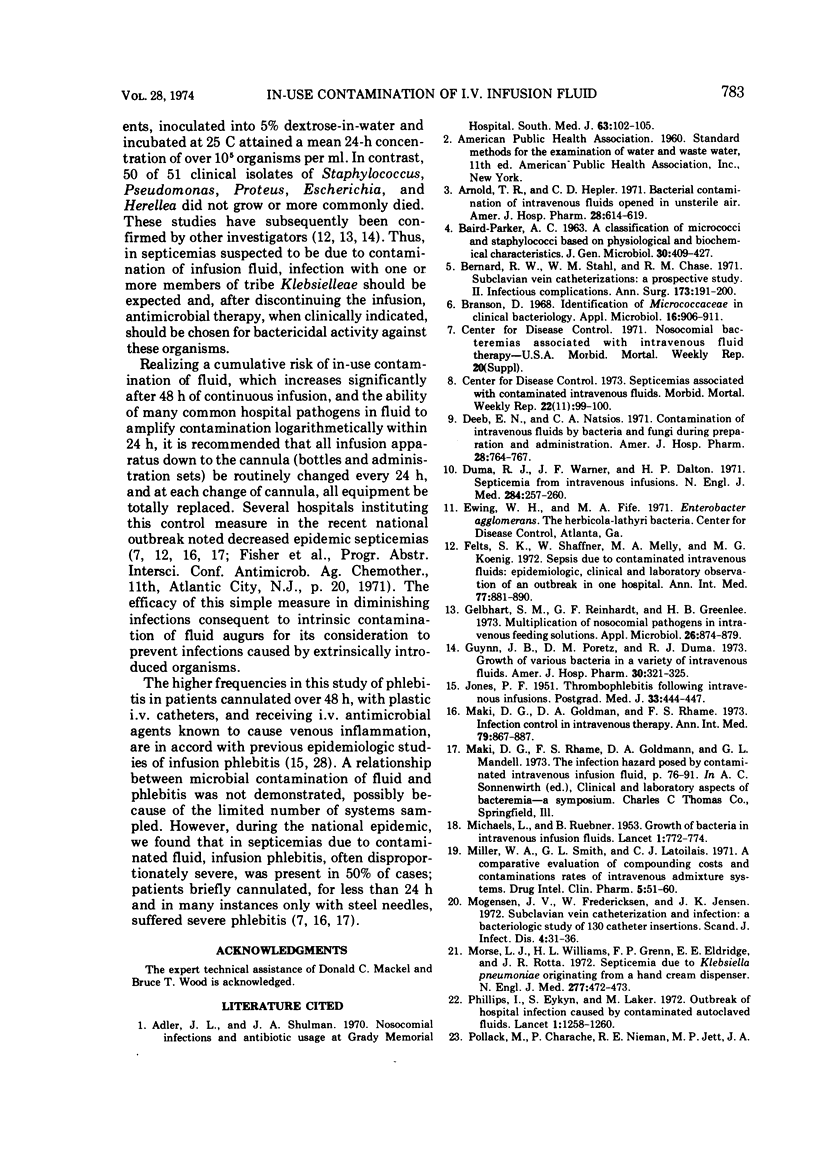
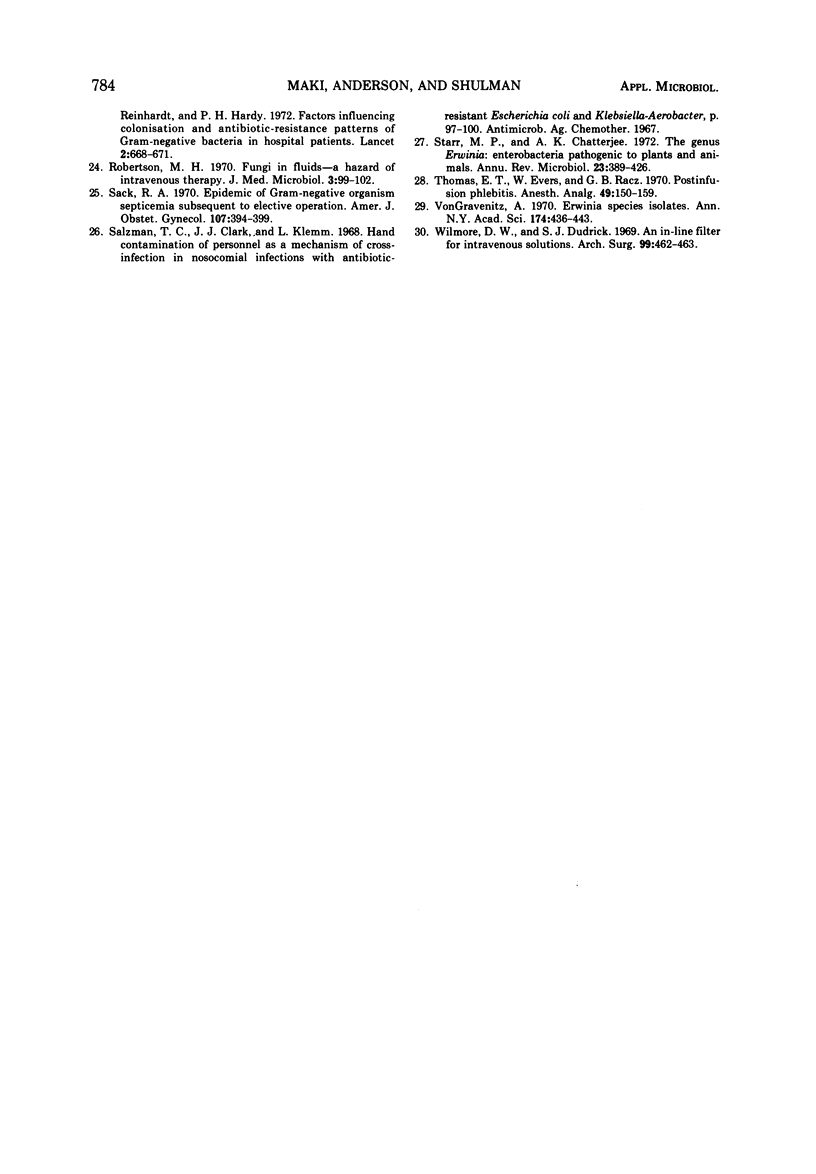
Selected References
These references are in PubMed. This may not be the complete list of references from this article.
- Adler J. L., Shulman J. A. Nosocomial infection and antibiotic usage at Grady Memorial Hospital: a prevalence survey. South Med J. 1970 Jan;63(1):102–105. doi: 10.1097/00007611-197001000-00024. [DOI] [PubMed] [Google Scholar]
- Arnold T. R., Hepler C. D. Bacterial contamination of intravenous fluids opened in unsterile air. Am J Hosp Pharm. 1971 Aug;28(8):614–619. [PubMed] [Google Scholar]
- BAIRD-PARKER A. C. A classification of micrococci and staphylococci based on physiological and biochemical tests. J Gen Microbiol. 1963 Mar;30:409–427. doi: 10.1099/00221287-30-3-409. [DOI] [PubMed] [Google Scholar]
- Bernard R. W., Stahl W. M., Chase R. M., Jr Subclavian vein catheterizations: a prospective study. II. Infectious complications. Ann Surg. 1971 Feb;173(2):191–200. doi: 10.1097/00000658-197102000-00003. [DOI] [PMC free article] [PubMed] [Google Scholar]
- Branson D. Identification of Micrococcaceae in clinical bacteriology. Appl Microbiol. 1968 Jun;16(6):906–911. doi: 10.1128/am.16.6.906-911.1968. [DOI] [PMC free article] [PubMed] [Google Scholar]
- Deeb E. N., Natsios G. A. Contamination of intravenous fluids by bacteria and fungi during preparation and administration. Am J Hosp Pharm. 1971 Oct;28(10):764–767. [PubMed] [Google Scholar]
- Duma R. J., Warner J. F., Dalton H. P. Septicemia from intravenous infusions. N Engl J Med. 1971 Feb 4;284(5):257–260. doi: 10.1056/NEJM197102042840508. [DOI] [PubMed] [Google Scholar]
- Felts S. K., Schaffner W., Melly M. A., Koenig M. G. Sepsis caused by contaminated intravenous fluids. Epidemiologic, clinical, and laboratory investigation of an outbreak in one hospital. Ann Intern Med. 1972 Dec;77(6):881–890. doi: 10.7326/0003-4819-77-6-881. [DOI] [PubMed] [Google Scholar]
- Gelbart S. M., Reinhardt G. F., Greenlee H. B. Multiplication of nosocomial pathogens in intravenous feeding solutions. Appl Microbiol. 1973 Dec;26(6):874–879. doi: 10.1128/am.26.6.874-879.1973. [DOI] [PMC free article] [PubMed] [Google Scholar]
- Guynn J. B., Jr, Poretz D. M., Duma R. J. Growth of various bacteria in a variety of intravenous fluids. Am J Hosp Pharm. 1973 Apr;30(4):321–325. [PubMed] [Google Scholar]
- JONES P. F. Thrombophlebitis following intravenous infusions; a review of its aetiology and prevention. Postgrad Med J. 1957 Sep;33(383):444–447. doi: 10.1136/pgmj.33.383.444. [DOI] [PMC free article] [PubMed] [Google Scholar]
- MICHAELS L., RUEBNER B. Growth of bacteria in intravenous infusion fluids. Lancet. 1953 Apr 18;1(6764):772–774. doi: 10.1016/s0140-6736(53)91897-2. [DOI] [PubMed] [Google Scholar]
- Maki D. G., Goldman D. A., Rhame F. S. Infection control in intravenous therapy. Ann Intern Med. 1973 Dec;79(6):867–887. doi: 10.7326/0003-4819-79-6-867. [DOI] [PubMed] [Google Scholar]
- Mogensen J. V., Frederiksen W., Jensen J. K. Subclavian vein catheterization and infection. A bacteriological study of 130 catheter insertions. Scand J Infect Dis. 1972;4(1):31–36. doi: 10.3109/inf.1972.4.issue-1.07. [DOI] [PubMed] [Google Scholar]
- Morse L. J., Williams H. L., Grenn F. P., Jr, Eldridge E. E., Rotta J. R. Septicemia due to Klebsiella pneumoniae originating from a hand-cream dispenser. N Engl J Med. 1967 Aug 31;277(9):472–473. doi: 10.1056/NEJM196708312770906. [DOI] [PubMed] [Google Scholar]
- Phillips I., Eykyn S., Laker M. Outbreak of hospital infection caused by contaminated autoclaved fluids. Lancet. 1972 Jun 10;1(7763):1258–1260. doi: 10.1016/s0140-6736(72)90981-6. [DOI] [PubMed] [Google Scholar]
- Pollack M., Charache P., Nieman R. E., Jett M. P., Reimhardt J. A., Hardy P. H., Jr Factors influencing colonisation and antibiotic-resistance patterns of gram-negative bacteria in hospital patients. Lancet. 1972 Sep 30;2(7779):668–671. doi: 10.1016/s0140-6736(72)92084-3. [DOI] [PubMed] [Google Scholar]
- Robertson M. H. Fungi in fluids--a hazard of intravenous therapy. J Med Microbiol. 1970 Feb;3(1):99–102. doi: 10.1099/00222615-3-1-99. [DOI] [PubMed] [Google Scholar]
- Sack R. A. Epidemic of gram-negative organism septicemia subsequent to elective operation. Am J Obstet Gynecol. 1970 Jun 1;107(3):394–399. doi: 10.1016/0002-9378(70)90565-x. [DOI] [PubMed] [Google Scholar]
- Starr M. P., Chatterjee A. K. The genus Erwinia: enterobacteria pathogenic to plants and animals. Annu Rev Microbiol. 1972;26:389–426. doi: 10.1146/annurev.mi.26.100172.002133. [DOI] [PubMed] [Google Scholar]
- Thomas E. T., Evers W., Racz G. B. Postinfusion phlebitis. Anesth Analg. 1970 Jan-Feb;49(1):150–159. [PubMed] [Google Scholar]
- Von Graevenitz A. Erwinia species isolates. Ann N Y Acad Sci. 1970 Oct 30;174(2):436–443. doi: 10.1111/j.1749-6632.1970.tb45571.x. [DOI] [PubMed] [Google Scholar]
- Wilmore D. W., Dudrick S. J. An in-line filter for intravenous solutions. Arch Surg. 1969 Oct;99(4):462–463. doi: 10.1001/archsurg.1969.01340160042009. [DOI] [PubMed] [Google Scholar]


